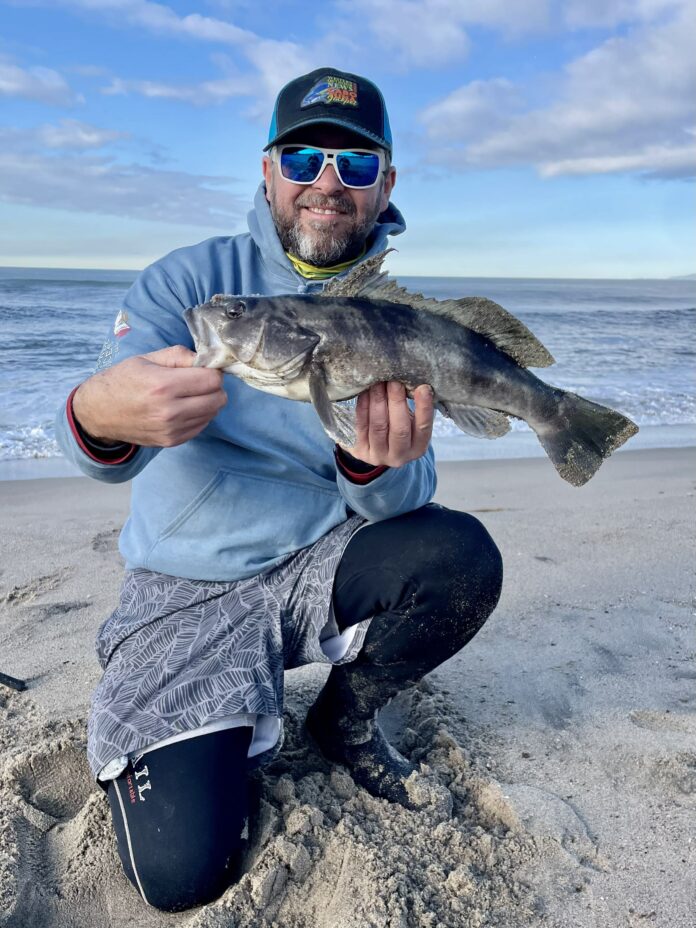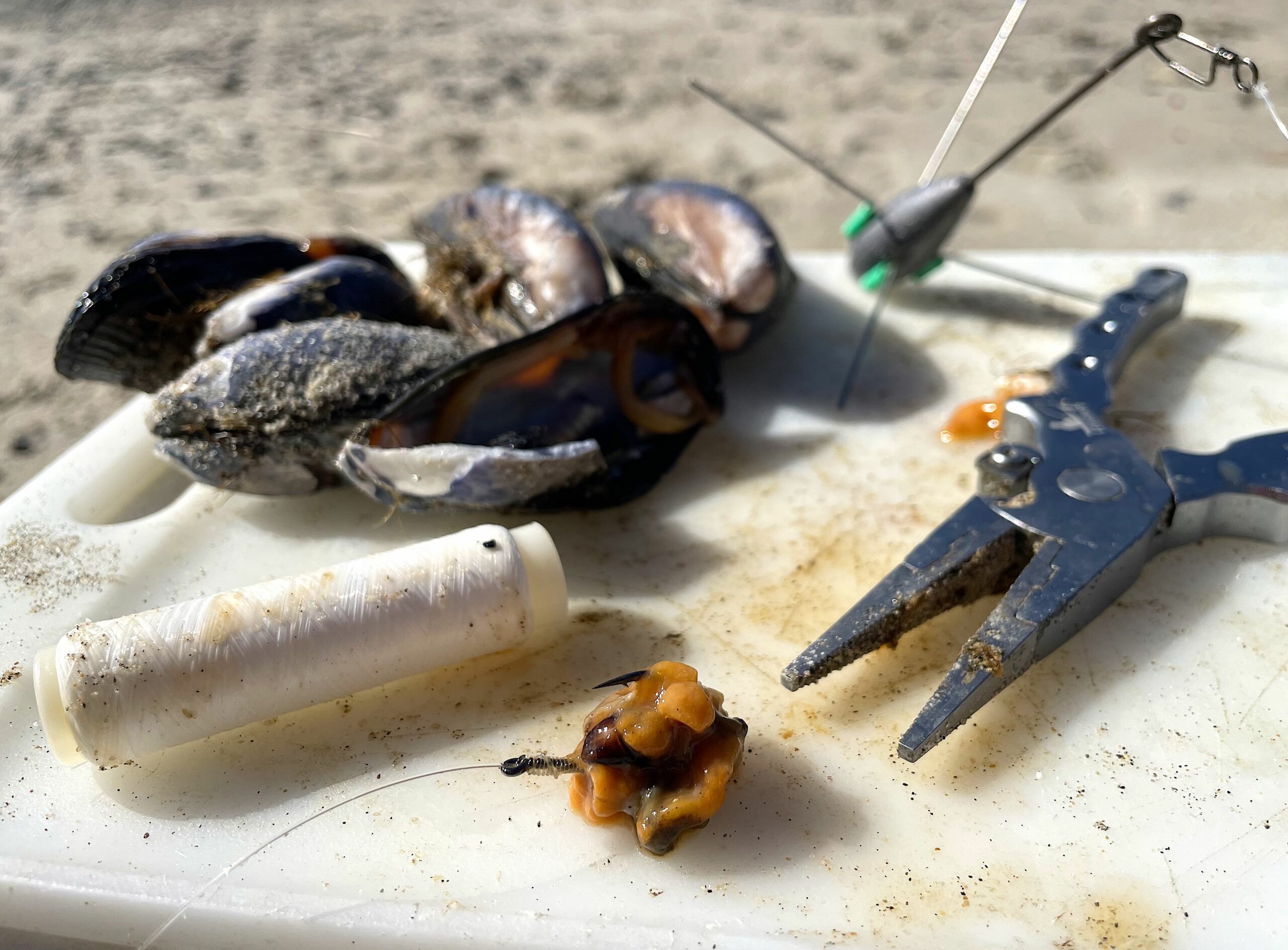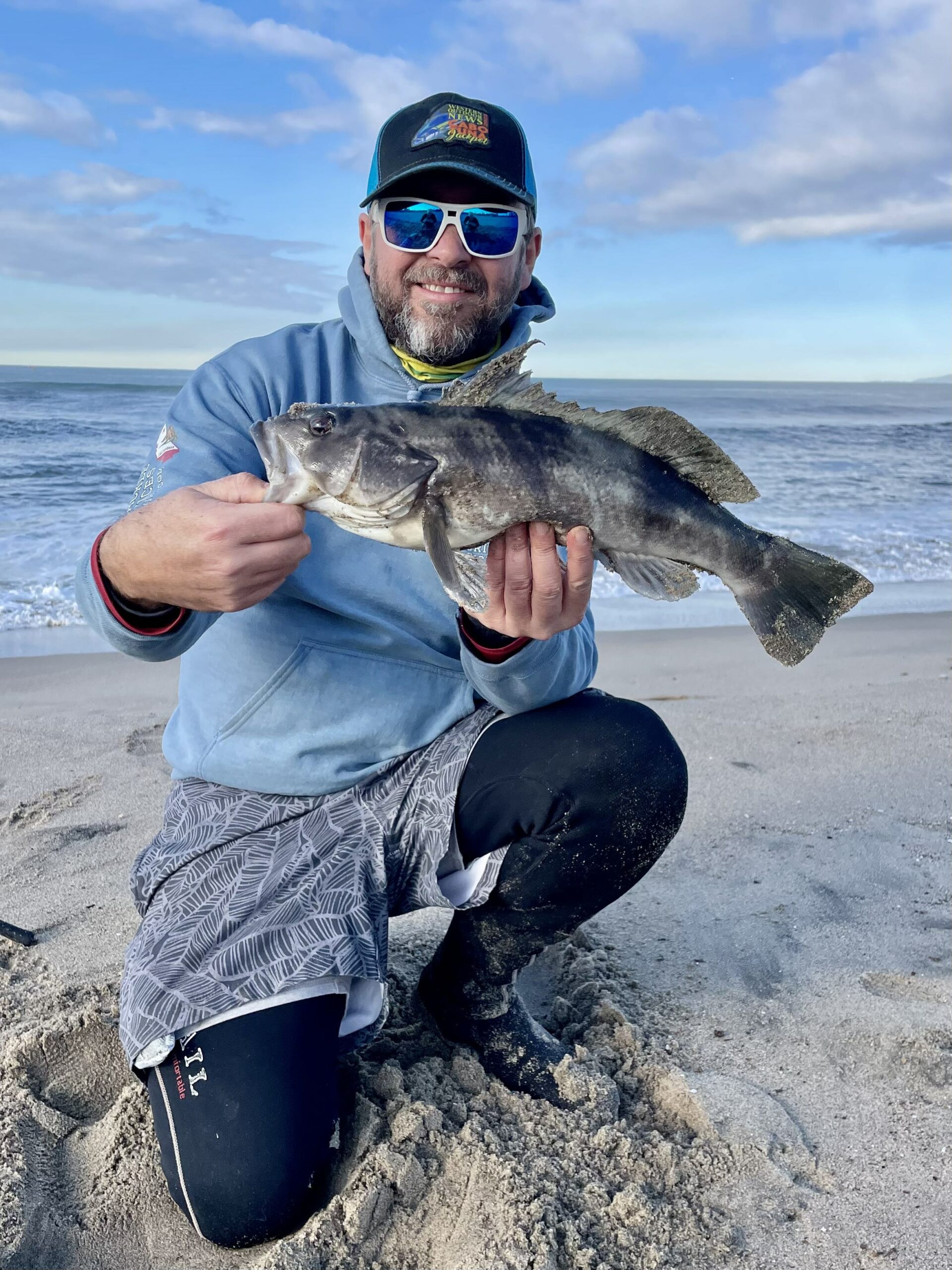
BY BEN HERVEY-MURRAY
WON Staff Writer
Water temperatures are rock bottom in Southern California right now with the steady procession of storms and north-to-south currents dumping cold water on our beaches and inshore. Most summer species – corbina, most other croaker species, leopard sharks – have departed for warmer climes, leaving the California beach caster with the various perch, rockfish and bass species to target (we’ll leave halibut for a separate feature).
With this change in target species also comes some tactical tweaks to keep the bites coming on guided trips and personal sessions during winter. Let’s start with bait.
Sand crabs are scarce in winter and not a consideration for bait right now in most areas, so we’ll disregard them. Fresh mussel meat is, however, an all-time winner for cold-weather species and will catch everything that swims, as will fresh prawn, bloodworms, lugworms and squid. Fresh is always far superior to frozen, and at this time of year bait quality can make the difference between a fun day and zero bites. So, working out the fresh supply of bait is the first task when thinking about hitting the beach.
Dealing with mussels first, these are pretty easy to collect at low tide around most rocky or structured areas. The state-wide legalities are straight-forward, too, according the CDFW’s information: The recreational season for California sea mussel (Mytilus californianus) and bay mussel (Mytilus trossulus) remains open year-round. The daily bag and possession limit is 10 pounds (in the shell) of California sea mussels and bay mussels in combination. Please check for local restrictions before you go foraging.
A pound or two of mussels is sufficient for a 3- to 5-hour session and they can be easily leveraged off a rock or piling with a small garden fork or old pliers around low water. Plan ahead so you get out the day before at low tide because it’ll be tough to find bait like mussels around the high tide mark. Keep them in big ziplock bag in the fridge overnight if necessary.

Tackle shops and seafood markets occasionally have fresh mussels, but the quality is unknown and they can spoil fast if not kept cool. They may also have been previously frozen, which kills a lot of the attractiveness of any bait. Collecting your own around low tide is the best way of ensuring good quality bait, and it’s free.
One of the reasons mussels work so well in winter is because of the trend towards fish frequenting rockier, more structured areas in colder conditions. In winter, the more open sandy beaches are devoid of many of the baitfish, sand crabs and shrimp that draw species to that area, so they back off to rockier areas with more food and cover. The rockier areas inevitably contain more mussels, clams and shellfish, so these become a regular food source for resident species. Thus using a fresh mussel as bait replicates a natural food source.
Freshly pumped or purchased live ghost shrimp, unfrozen seafood market shrimp, clam meat, live blood or lugworms and squid also works well, with the freshest, most local option your go-to bait from that menu.
Now you’ve got some awesome fresh bait, let’s look at planning ahead using tide and swell forecasts in winter. As we’ve experienced recently, the cooler months often see a procession of storms throw up some big swells and pitching your session between these peaks is key. Download two or three reliable surf forecasting apps (Magic Seaweed, Epic and Surfline are good options) and plan a few days ahead. Look for smaller waves in the 1, 2 or 3-foot range with wave power ratings in the 50 to 250 kilojoule (Kj) range, and avoid anything significantly larger.
Tides are also more important than at any other time of year – check out the new Tide Guide feature in this issue for an easy reference to what’s going on in the coming days. Often, the rockier beaches need a decent covering of water from a high tide in the upper tier (5- to 7-foot highs) of the regular tidal cycle to work well. A good example of this was experienced recently when fishing a typical rocky SoCal beach.
Arriving at dawn for the last push of the incoming tide building up to an 8.30am, 5.7-foot high tide, we fished into the sandy patches between rocks and jetties that were invisible at that state of tide. Thankfully, knowing the beach and reading the structure meant for little lost gear in the rocks. Fast-forward to 11am, and the tide was now at about 2-feet above the average low, leaving much of the rocky structure just below the surface and very little depth between for fish to hunt and forage. Not ideal.
We had most of our bites between 9 and 10am when the tide was ebbing (going out) hard back over the food-laden structure. Our timing was just right, but if we’d started fishing later in the day when the tide wasn’t up and giving the fish enough water to forage within casting distance and find our baits, we’d have caught very little. Timing and prior-planning are key in winter.

This also illustrates another factor to consider: that of moving water. When the tide starts to really shift, just like in that sweet 9–10am slot I mentioned above, fish use the moving water to move and find food, with the scent from any bait or prey item carried far and wide across the reef to interested parties. It’s efficient for the fish to feed in these short windows when conditions for locating prey are optimal, plus with water temperatures rock bottom, their metabolism is going to slow down somewhat, so exploiting the minimum-effort-maximum-food equation is something the fish will be doing.
In short, during winter, windows of opportunity are often narrow, but learning when these bites times occur will lead to some solid sport. Small swells, big tides and moving water all help.
So, you’ve scored fresh bait and worked out your window of opportunity in terms of bite times. Let’s look at rigs and tackle. First, let’s dispel one big myth. Braided main line is great for cutting through lily pads and vegetation, but do you know what its absolute kryptonite is? Rocks, or anything covered in hard, uneven structure, like rocks with mussels. But braid is awesome for casting due to its low diameter and having zero stretch, and I like it as a mainline for most types of fishing.
To counter braid’s lack of abrasion resistance, simply use a long mono or fluorocarbon casting leader between the braid and rig. I like 20- or 30-pound fluorocarbon for this with 20-pound the standard for bait-and-wait surf fishing for smaller species. This casting or abrasion leader is about 12-feet long on my 12-surf rods, which allows me to have a turn or two on the reel (a Penn Battle 3, 4000-size, loaded with 20-pound braid) and a 3-foot drop between the top of the rig and rod tip. An Albright / crazy Alberto with a Rizzuto finish, or back-to-back uni / grinner is the ideal braid-to-fluoro leader knot for this kind of set-up.
This type of leader serves two purposes. First, around rocky areas it offers a highly abrasion-resistant section above the fragile braid that will withstand being dragged over rocks and structure with a fish attached when straight braid would soon give up. Second, it takes the force and shock of the cast.
The equation to be aware of in this regard is that you need ten pounds of breaking strain in your main line or leader for every ounce of sinker you wish to cast. So a 20- or 30-pound leader is perfect for a 2- or 3-ounce sinker, which is ideal for this style of fishing. Low-visibility fluorocarbon is also a bonus when trying to keep everything stealthy in shallow, clear water.
A note on sinker choice, too. Pining the rig in place so it’s not bouncing around and finding snags or rocks is vital. If your rig is moving every time current picks up or a wave comes along, it will find a tackle-eating snag. But, if you’ve identified a section of clear ground by either knowing the beach well, using watercraft to read the structure or simply casting around until you’re hitting sand, you’ll lose very little gear. I love using wired surf sinkers for this as they will anchor the rig in place, whereas a pyramid or similar will roll or bounce when the current or swell picks up, finding snags in the process.
Pyramid sinkers also more prone to snagging because of the shape. Reel it back over some rocks, and the shoulders on that style of sinker are prone to getting jammed or caught. But if a wired surf sinker gets stuck by virtue of the wires getting hung up, gradual pressure releases the wire arms and the sinker releases. As an example, using a 3-ounce wired surf sinker on the aforementioned session, I got hung up on rocks a number of times but was able to get my entire rig back with gradual, sustained pressure. I didn’t lose a single rig in four hours of fishing.
Rig-wise, I use single dropper loops when fishing rough ground because of the simplicity and ease of replacement. For general species, these are made from 15- or 20-pound fluorocarbon with a 12-inch branch line and size 1 J-style hook tied so it sits just above the sinker when held up vertically. A small sinker clip secures the weight and a barrel swivel at the top of the rig, to which the abrasion-resistance leader is tied, completes the set-up. Even if I lose the entire rig, it’ll only take a minute to tie an entire new one.
To bait up, using a small rock or pliers, I crush the shell of a large fresh mussel and gently cut the meat out, hooking it on via the tough sections of the meaty parts. Using a few wraps of light bait elastic to secure the bait to the hook, so the soft meat forms a small grape-size blob just below the hook bend with the point and barb well exposed, means it’ll stay on during the cast and resist the attentions of small fish.
Worm baits are threaded on up the hook shank with the hook exiting half-way down the body – a tiny 2mm chunk of plastic Gulp! sandworm or Fishbites bloodworm is then threaded on the hook to keep the worm from sliding back off the hook and masking the point. Squid is cut into strips and hooked on twice, leaving an enticing trailer, and shrimp is mounted with bait elastic in a similar way to the mussel meat. Be sure to keep the hook point exposed.
Bites are unmissable rattles, big pull rounds or slack line as the fish swims towards you. Grab the rod immediately and boss the fish towards you, keeping it moving constantly. If you stop, the fish will likely find structure and it’s bye-bye. Don’t stop reeling until that fish is on the sand.
In summary, winter surf fishing requires a little more attention to fishing around hard, food-laden structure, using seasonal fresh baits and identifying bite windows when plenty of water is moving over your preferred venue. Using these tactics, I’ve caught lots of surf perch species, sargo, croaker, rockfish and bass this season. You really don’t know what’s going to turn up, which is one of the things I love about this style of surf fishing.


